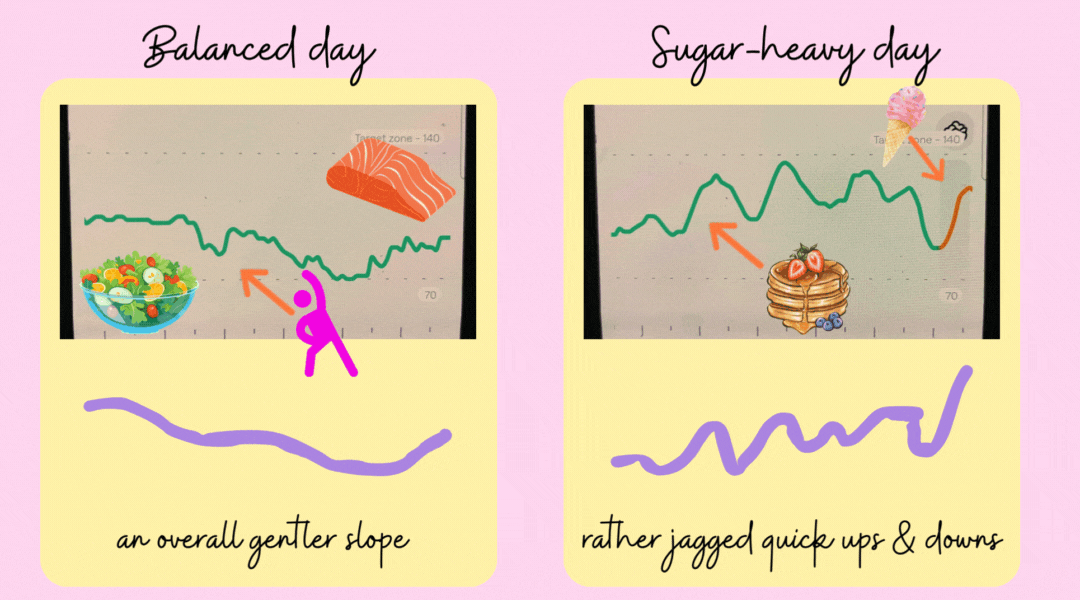What I learned from wearing a Continuous Glucose Monitor
More tips for the sweet-tooth & a great tool to better understand your health

And we’re back with more on the topic of SUGAR 🍭🍰🧁
Nerdy nutritional mad-scientist that I am, I’ve been wanting to try out a continuous glucose monitor (CGM) for YEARS and so I was so excited to finally do it! Here are some of the more interesting take-aways that I’ll be sharing about today:
You can’t always feel sugar highs and lows, but there are signs
Meal spacing and breakfast are important
My experience with breastfeeding and hypoglycaemia
Changing my environment changed my glucose response
It IS possible to still enjoy sweet things without causing a spike
Today is NOT a deep dive into nutritional research but if you want to know more of the nitty gritty, I’d be happy to provide - just let me know! Instead, I’m sharing my experience from a few months ago and more tips around eating for health. Whether you love sweets or not, have blood sugar problems or not, there’s something here for you.
If you would like more tips, check out my recent post Blood Sugar Balance. Additionally worth checking out is a recorded interview with Nikko Kennedy, were I go into some of the physiology behind the scenes of blood sugar spikes.

🍦Tip #1 - Playing around …all in the name of science & self care
So you've decided to take the plunge and buy a glucose monitor - HuRRay! This will be fun!
It may not be typical advice but in my humble opinion, the first thing to do after you’ve settled in to using your monitor for a while, is to start experimenting experimenting. That’s right - you have my permission to try a variety of different foods - even sweets and see how your body reacts. BUT, here’s the fine print: it would be a good idea to check in with your primary care provider too, especially if you’re seeing some wild numbers with just your normal diet.
Anyway, just saying, this kind of “experimentation” is all in the name of science AND caring for yourself… it’s is not an excuse to go crazy, but do try to have some fun!
🍭Tip #2: Try to really notice how you feel on days you eat sugar vs other days.
I was surprised that while I couldn’t feel blood sugar spikes, I noticed slight sweating and mild headaches with highs and lows. It may sound odd, but I also noticed more lethargy, mood swings and body odour on days when I had poor blood sugar balance. TMI? The point is - see what signs your body gives you!
Below, left, you see an “average” day for me. …Okay, it’s not completely average because I have a 1 year old, which means my sleep is not the best (hello, teething) and I was breastfeeding day and night. …but I mean average in that I stuck to my usual diet, emphasising whole foods, and even had a little dark chocolate. It’s hard to see the numbers on the pictures but my set goal range was to stay between 70 and 140, with gentle slopes instead of huge “hills and valleys”.
Above, right, you’ll notice that I still achieved my “goal” numbers wise, but there are some significant hills and valleys as I ate things like waffles with syrup, ice-cream, and (of course) cake.
🧁Tip #3 - If you’re a woman, especially a menstruating one, the time of the month that you measure matters!
While I didn’t get to test this fully, as I only wore the continuous monitor for 14 days, the research is pretty clear that women in the Follicular vs Luteal halves of their cycles see quite different reactions to carbohydrate intake.
Ideally, one would consistently measure for whole month, noting differences in readings and symptoms for every phase of the menstrual cycle and then do it AGAIN to see if there’s a similar pattern in month 2.
Also,
Lemme tell ya’…. it yields SO much more information than the standard glucose test during pregnancy and even blood testing (like fasting glucose/insulin) are only snapshots in time. Remember how I mentioned not being able to feel blood sugar spikes? …Yeah, sugar lows can be pretty hard to detect too - especially if you’re asleep! I had no idea that I was having major crashes at night until I wore the CGM and quickly realised that nighttime breastfeeding was the culprit.
Fun Fact: Did you know, Elizabeth I was a total sweet tooth!?
Dr. Amy Boyington makes history fun and quick and loves to cover women in history. Go check out her TikTok and IG:
🍰Tip #4 - Meal timing and breakfast
Many of you will already know that breakfast is important, but do you know why? It’s well established in medicine and nutritional research that meal timing plays a role in our circadian rhythm. In effect, everything from nutrient absorption to hormone release and quality of sleep have to do with meal timing. Ideally, the body can go 4-6 hours between proper meals with no problem, allowing for plenty of time for digestion, however many with unstable blood sugar or higher energy needs will likely need to eat more frequently.
Breakfast is especially important when trying to improve blood glucose levels. While waffles and sweet cereals are common at the American breakfast table, carbs tend to send us on a rollercoaster of sugar highs and lows that creates instability for the whole day. In contrast, breakfasts with emphasis on fat and protein are shown to help increase satiety, improve blood sugar stability and even help maintain muscle mass.
🍡Tip #5 - The environment plays a role.
During the time I wore the monitor, we went camping and spent 2 nights and 3 days mostly outside, barefoot, and in an environment with almost no artificial light, noise pollution, or smog. Within 24 hours of arriving I already noticed less variation in my glucose readings, despite eating about the same as I usually would.
We forget that modern schedules, pace of life, and things like blue light or contact with the earth’s surface can make quite a difference in our health outcomes.
🥧Tip #6 - You can have your cake and eat it too (without a spike)
If you’re using a glucose monitor, try pairing a sweet with fat or fiber. I personally don’t think it’s a reasonable goal to swear off sugar entirely (even though we’d be a lot better off for it). The fact is that most of the time, trying to be too extreme leads to binging or other extremes.
Side note: Well worth the watch, here is my favorite movie binge scene of all time, from the movie, Chocolat:
In short, the simplest way to enjoy some sugar/cake/candy, is to wait until the end of a healthy meal to have it, but if you’re craving something sweet between meals and don’t want to cause a spike, you’ll have to do a little planning. Simply eating a stick of cheese, a tiny serving of lentils or some veggies right before your treat will make a huge difference.
Now, I know it’s becoming popular, mainly due to one person on Instagram, to use vinegar, take herbs, or even pop a pill (that they sell, of course) to naturally reduce a sugar spike when eating sweets, but I would encourage the use of timing and whole foods as I don’t see these other options as sustainable (which I may discuss in greater detail if you’d like me to, but for now I’ll just stay off the soap box).













